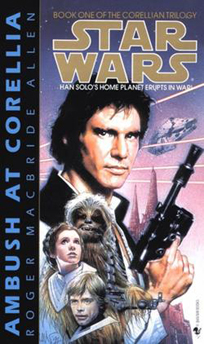Drawing from my memory of reading Roger MacBride Allen’s “The Corellian Trilogy” 19 years ago, I recalled Han’s nasty cousin Thrackan Sal-Solo (leader of the Human League, not to be confused with “Seinfeld’s” Human Fund), Anakin Solo exploring caves, the mysterious Centerpoint Station, and … that’s about it. On this re-read of the trilogy’s first book, “Ambush at Corellia” (1995), I see why so much of the story didn’t stick: It’s very deliberately written.
Still, the 308 pages fly by quickly. (Unfortunately, they flew past the line editors, too, as – like too many “Star Wars” paperbacks in the Bantam era — it’s packed with typos and spelling errors. It’s distracting, but not a fatal flaw.) Allen has an excellent grasp of all the characters, and the first chapter even reminded me a bit of Brian Daley’s pulpy style of writing Han and Chewbacca. That sense went away as the storytelling got more deliberate, but still, if you want a good Han Solo story and you’ve already read Daley’s and A.C. Crispin’s trilogies, “The Corellian Trilogy” is a good next stop.
Aside from a long chapter about New Republic Intelligence agent Belindi Kalenda crashing into the Corellian ocean, I didn’t mind Allen’s tendency to overwrite. The previous book on the timeline, “The New Rebellion,” has an epic plot in the sense that the whole galaxy is in danger from one madman, but things happen so easily for the characters (for example, galaxy-wide communication is instantaneous) that I ultimately didn’t believe or care what was happening. “Ambush at Corellia” includes trivial moments such as Han explaining the history of the Corellian system to his kids (with Anakin sitting on his lap, naturally) on the flight from Coruscant to his home planet, but that gives the story more heft. By book’s end, the Corellian System is under an interdiction field, signaling that the trilogy’s action will all take place in this system. It makes for a cozier yarn, but also one I can believe in.
At the time of the book’s publication, the opportunity to learn about Corellia (long known to be Han’s home planet, but not shown to readers until now) was the big hook. Indeed, it is a fascinating system with five habitable planets; political intrigue between the humans, Selonians and Drall; and mysterious, perhaps unnatural, origins for the whole system. Anakin discovers a cone-shaped underground cavern that – if memory serves – is the engine that moved the planet to this system. It also might have something to do with the stars Thrackan’s Human League is blowing up and using as a threat. (Yes, this is another of those superweapon stories, but at least it’s a small element of the plot here.)
Back in 1995, readers were probably wary of Jacen, Jaina and Anakin, who get their first significant characterization in this book, due to the “Oliver from ‘Brady Bunch’ Factor.” Would the Solo kids ruin “Star Wars” as they grew into adults? The twins – who were also starting to be written about in Kevin J. Anderson’s “Young Jedi Knights” books in ’95– are about 10 and Anakin’s a couple years younger. In retrospect, now that the Solo kids are safely ensconced as beloved characters (especially Jaina, since she’s still alive), it’s fascinating to rediscover that Allen was among the first authors to shape their characters. In fact, since “Young Jedi Knights” focused on the twins, Allen is the first to give a personality to the precocious Anakin. If midichlorian counts were still a thing, Luke would no doubt find a rival in his nephew. And of course, Anakin is also a convenient plot device as he uses his almost magical skills to find the secret tunnel that leads to the cone-shaped cavern.

In “Ambush at Corellia’s” B-plot, Lando goes down a list searching the galaxy for a rich wife, with Luke as his chaperone. Whereas the “Black Fleet Crisis” trilogy gave us the “Lando Calrissian Adventures”-style Lando – an all-purpose sci-fi adventurer – this trilogy gives us Kevin J. Anderson’s romantic Lando, but don’t let that throw you off. While Lando’s scheme is absurd on the surface, Allen is a much better writer than Anderson (who massacred the portrayal of Lando’s flirtation with Mara, which was a stupid pairing anyway), and his meeting with future wife Tendra Risant is precisely what a Lando romance story should be. He’s suave, but also genuinely interested in Tendra as a person.
“Ambush at Corellia’s” exploration of politics and economics resonates in a way that few “Star Wars” books of the Bantam era do, unless you count gamesmanship in halls of the Senate building. (With “Episode I,” George Lucas would signal to writers that politics were fair game in the saga.) Corellia’s economy is in rough shape – as is that of the whole sector, including Tendra’s planet, Sacorria. Tendra notes that government agents following people around is one of the few growth industries.
Along those same lines, Sacorria is looking to censor the holonet (essentially the GFFA’s Internet) and outlaw marriages to off-worlders. With the obvious parallels to the NSA, Internet freedom, marriage rights, immigration, and the general notion that bad economic times always correspond with growing government, Allen couldn’t have made “Ambush at Corellia” more timely if he had written it today. Then again, it’s also a reminder that these issues never completely go away.

